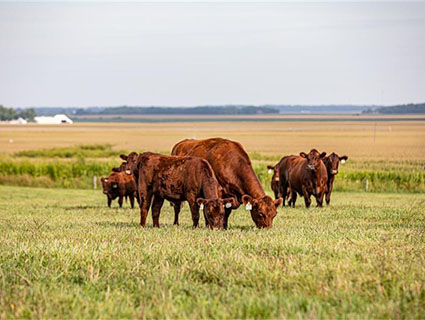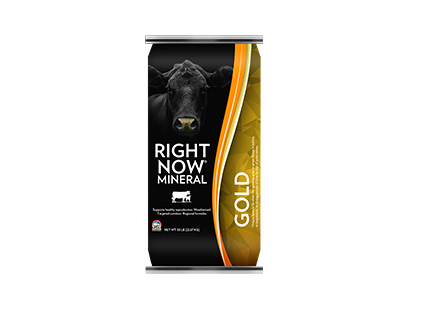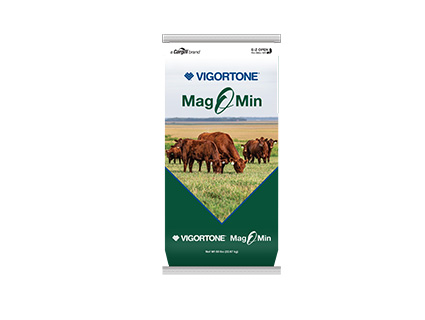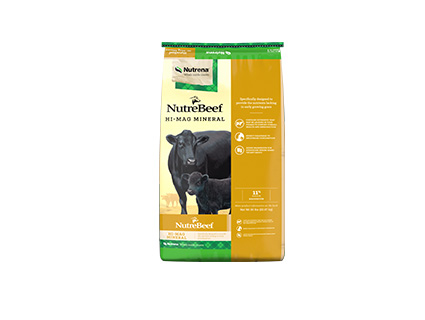Grass Tetany Risk Assessment
 Fast-growing grass is an exciting sign for producers – it’s finally time for the cows to harvest their own feed! New growth, cool-season grass is highly palatable and very nutritious, but like most things, it brings on a whole new set of challenges. There are many effective approaches to managing grass tetany, so it helps to understand the underlying risk factors for grass tetany before developing the right plan for your operation.
Fast-growing grass is an exciting sign for producers – it’s finally time for the cows to harvest their own feed! New growth, cool-season grass is highly palatable and very nutritious, but like most things, it brings on a whole new set of challenges. There are many effective approaches to managing grass tetany, so it helps to understand the underlying risk factors for grass tetany before developing the right plan for your operation.
Magnesium
Magnesium is essential for many enzymatic reactions in the body and cellular energy production. Grass tetany, more correctly defined as hypomagnesemic tetany, is caused by low blood levels of magnesium. Magnesium is required in the diet of all cattle daily as it cannot be readily mobilized in the animal. Seventy percent of the magnesium in the body is stored in the bone and as an animal ages, bone stores become more difficult to mobilize if magnesium intake is not adequate. Regardless of the time of year, magnesium is always required in the diet. However, magnesium requirements increase during gestation and lactation.
Magnesium Absorption
In most cases, magnesium concentration in forage is adequate to meet the animal’s requirement during most of the year. However, during early vegetative growth, potassium concentration spikes in grass which can inhibit absorption of magnesium in the rumen. Spring magnesium supplementation is often talked about, but high potassium is the true root cause of grass tetany. Unfortunately, it’s impossible to reduce potassium concentration in vegetative grass so the best option is to feed more magnesium so more can be absorbed.
Symptoms
Much like anaplasmosis, grass tetany can be hard to diagnose - early symptoms are mild and difficult to observe and death occurs quickly after the onset of symptoms. If caught in time, grass tetany is easily treated with intravenous calcium magnesium gluconate solution. However, grass tetany is usually not caught in time. Early signs of grass tetany include excitability, muscle twitching, and stiff gait. The reason muscle tetany develops during magnesium deficiency is because magnesium is essential in the relaxation of muscle tissue. Without adequate magnesium, muscles continue to contract, and the animal loses control of voluntary functions. Realistically, it is much easier to manage grass tetany with a proactive approach.
Soil Fertility
With a brief overview of grass tetany, it is now time to talk about assessing risk for grass tetany in your operation. Understanding your operation’s soil type and fertility is the most useful tool in determining your risk level for grass tetany. Soil factors that increase your risk of grass tetany include: high levels of nitrogen and potassium fertilizer application (this can be in the form of synthetic fertilizer or manure), sandy soils, low soil pH or low soil magnesium. If heavy fertilization is part of your forage program, consider split applications of fertilizer in spring and fall and be sure you are soil sampling to maintain nutrient balance. High nitrogen and potassium fertilization in the spring can reduce the uptake of magnesium by the plant, increasing your risk for grass tetany. Sandy soils can easily leach nutrients like magnesium and calcium, so they are especially at risk for over fertilization. Low soil pH not only reduces phosphorus uptake by the plant, but it often means reduced calcium and magnesium concentration in the soil. Remember when you lime fields to manage pH, you are also delivering some levels of magnesium to the soil and thus increasing concentrations in the plant. Managing soil pH at >5.5 along with reducing nitrogen fertilization in the spring will also encourage the growth of legumes which contain higher concentrations of magnesium and calcium while discouraging the negative effects of aluminum on magnesium update by the plant.
Animal Risk Factors
Magnesium requirements in the diet change based on the cow's stage of production. Lactating cows require the greatest amount of magnesium in the diet, so on early-growth forage, they are at highest risk to develop grass tetany. Overlaying your calving season with green up timing can be useful in determining your operation’s risk of developing grass tetany. Cows in early lactation around turnout time are at highest risk for developing grass tetany. As discussed earlier, older animals have a difficult time mobilizing magnesium from the bone, so it is more important to achieve dietary requirements of older animals. One interesting fact about magnesium is that circulating supplies in the animal will only last about four days, so it is essential to provide daily supplementation of magnesium while potassium concentrations in the grass are high. Younger cattle are less likely to develop grass tetany because they are more capable of mobilizing magnesium stores in the bone to correct for an absorptive deficiency of magnesium. Managing cows to appropriate body condition can also reduce the risk of grass tetany. No class of animal is exempt from grass tetany, but by assessing animal risk factors, you can be more proactive in reducing the incidence of the problem.
Supplemental Magnesium
Since fertilizing pasture with magnesium is not practical, our best option is to supplement magnesium in the diet. Magnesium oxide is the most widely used form of supplemental magnesium. Magnesium oxide is available in the animal but achieving intake of high magnesium free-choice minerals can be difficult since the product is thought to be bitter. To help encourage intake of high magnesium minerals, don’t provide additional sources of salt, and manage mineral feeder location to achieve target intake. Dolomitic limestone can be another source of magnesium used in the mineral but isn't very available in the animal. Magnesium isn't the only essential nutrient to managing around grass tetany. Make sure salt and vitamin D are included in your free-choice mineral since salt is required for magnesium uptake in the rumen and vitamin D is essential for bone mineralization and resorption along with calcium absorption. Calcium and phosphorus nutrition can also play a role in grass tetany. Focus on maintaining a nutritionally adequate ratio of calcium to phosphorus and don’t overfeed phosphorus when animals are at risk of grass tetany. As always, supply good vitamin and trace mineral nutrition to meet the requirements of the animal. High levels of aluminum can also depress magnesium absorption by the plant and animal so make sure you evaluate the ingredient list in your mineral to look for any non-feed-grade ingredients that might contain aluminum. Although magnesium nutrition is important during the spring, there are also negatives to feeding high levels of magnesium. First, magnesium can be a gut irritant and reduce overall nutrient utilization in the animal, so only feed high levels of magnesium when it is truly needed. Also, magnesium can compromise intake of a free choice mineral, so it is important to track and actively manage intake to meet label recommendations. Lastly, magnesium takes up room in a free choice mineral formula which can sacrifice supplying more important nutrients like phosphorus, calcium, and trace minerals when they are needed in the animal. As with most things, balance is the key to managing grass tetany. Good mineral nutrition along with balanced soil fertility is the place to start in managing the challenge.
Explore Cargill Mineral Portfolio

Right Now Gold
Right Now® minerals are formulated to allow you to match the mineral feeding program to the growing seasons, forage conditions and nutritional needs of your cattle.

Vigortone Minerals
Wherever you are, Vigortone® works. Formulated for every stage of production with targeted nutrition for every region, Vigortone delivers consistent animal performance.

NutreBeef Hi-Mag Mineral
NutreBeef® products are designed to meet all the needs of cattle in every stage of development and phase of production.
